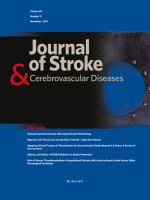Metabolic Syndrome and the Risk of Ischemic Stroke
Authors
Affiliations
- 1Isfahan Cardiovascular Research Center, Isfahan Cardiovascular Research Institute, Isfahan University of Medicine Sciences, Isfahan, Iran.
- 2Cardiac Rehabilitation Research Center, Isfahan Cardiovascular Research Institute, Isfahan University of Medicine Sciences, Isfahan, Iran. Electronic address: gharipour@crc.mui.ac.ir.
- 3Cardiac Rehabilitation Research Center, Isfahan Cardiovascular Research Institute, Isfahan University of Medicine Sciences, Isfahan, Iran.
- 4Cardiac Rehabilitation Research Center, Isfahan Cardiovascular Research Institute, Isfahan University of Medicine Sciences, Isfahan, Iran; Student Research Committee, Mashhad University of Medical Sciences, Mashhad, Iran.
- 5Isfahan Cardiovascular Research Center, Isfahan Cardiovascular Research Institute, Isfahan University of Medicine Sciences, Isfahan, Iran; Saw Swee Hock School of Public Health, National University of Singapore, Singapore.
- 6Neurology Department, Tehran University of Medical Sciences, Tehran, Iran; Surveillance Department, Isfahan Cardiovascular Research Institute, Isfahan, Iran.
- 7Interventional Cardiology Research Center, Isfahan Cardiovascular Research Institute, Isfahan University of Medicine Sciences, Isfahan, Iran.
Abstract
Background: Metabolic syndrome (MetS) is recently proposed as a predictor for the occurrence of vascular defects causing ischemic stroke. However, details on the association of MetS with stroke are scare in our region. The present study aimed to assess the predictive value of MetS and its components for stoke among the Iranian population.
Methods: A longitudinal population-based study was conducted on adults aged 35 years or older who were living in 3 districts in central part of Iran and followed for 10 years. Stroke was diagnosed using World Health Organization guidelines, and MetS was defined according to the Adult Treatment Panel-III definition.
Results: Among the 5398 subjects, 2021 suffered from MetS with an incidence of 37.4%. The incidence rates of stroke in those with and without MetS were 2.6% and 1.1%, respectively, with a higher significance in the former group (P = .026). Compared to the controls, participants with stroke exhibited a higher prevalence of some components of MetS including hyperglycemia and hypertension. On Cox proportional hazard analysis, the hazard ratio for a long-term risk of ischemic stroke was 1.37 overall (95% confidence interval: 1.15-1.63, P < .001) in subjects with MetS. Considering different components of MetS, hyperglycemia (hazard ratio = 1.83, P = .011) and hypertension (1.74, P = .019) could effectively predict occurrence of long-term ischemic stroke. Conclusion: MetS and its main components can be potent predictors for long-term ischemic stroke. Thus, the focus should be on identification and appropriate control of MetS components to prevent stroke occurrence.
Keywords: Metabolic syndrome; hazard; prediction; stroke.
How to Cite
. 2017 Feb;26(2):286-294. doi: 10.1016/j.jstrokecerebrovasdis.2016.09.019.. PMID:27769610.

